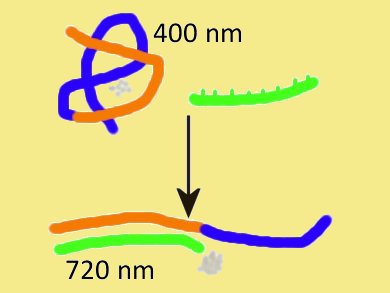Bifunctional DNA oligonucleotides can serve as templates for few-atom silver clusters and as recognition sites for target DNA strands. These strands have beed used by Jeffrey T. Petty and colleagues, Furman University, South Carolina, USA, as an optical sensor for oligonucleotides.
They created a sensor strand with two components: the 5’ segment (pictured, blue) as a template for cluster formation and the 3’ segment (orange) to recognize the target oligonucleotide (green) through complementary base pairing. Without this target, the sensor strand selectively bound a cluster of 7 Ag atoms that absorbed at 400 nm and folded the DNA host. Upon target association, the sensor unfolded to reveal the bonding site for a cluster of 11 Ag atoms with near-infrared absorption at 720 nm.
The high molecular brightness of this near-infrared fluorophore and the low spectral background in the range of 650–900 nm favors sensitive analysis in spectrally challenging blood and serum samples. This may reduce sample preparation and present an alternative approach to sensing analytes in biological environments.
- Optical Sensing by Transforming Chromophoric Silver Clusters in DNA Nanoreactors
J. T. Petty, S. P. Story, S. Juarez, S. S. Votto, A. G. Herbst, N. N. Degtyareva, B. Sengupta,
Anal. Chem. 2011.
DOI: 10.1021/ac202697d



